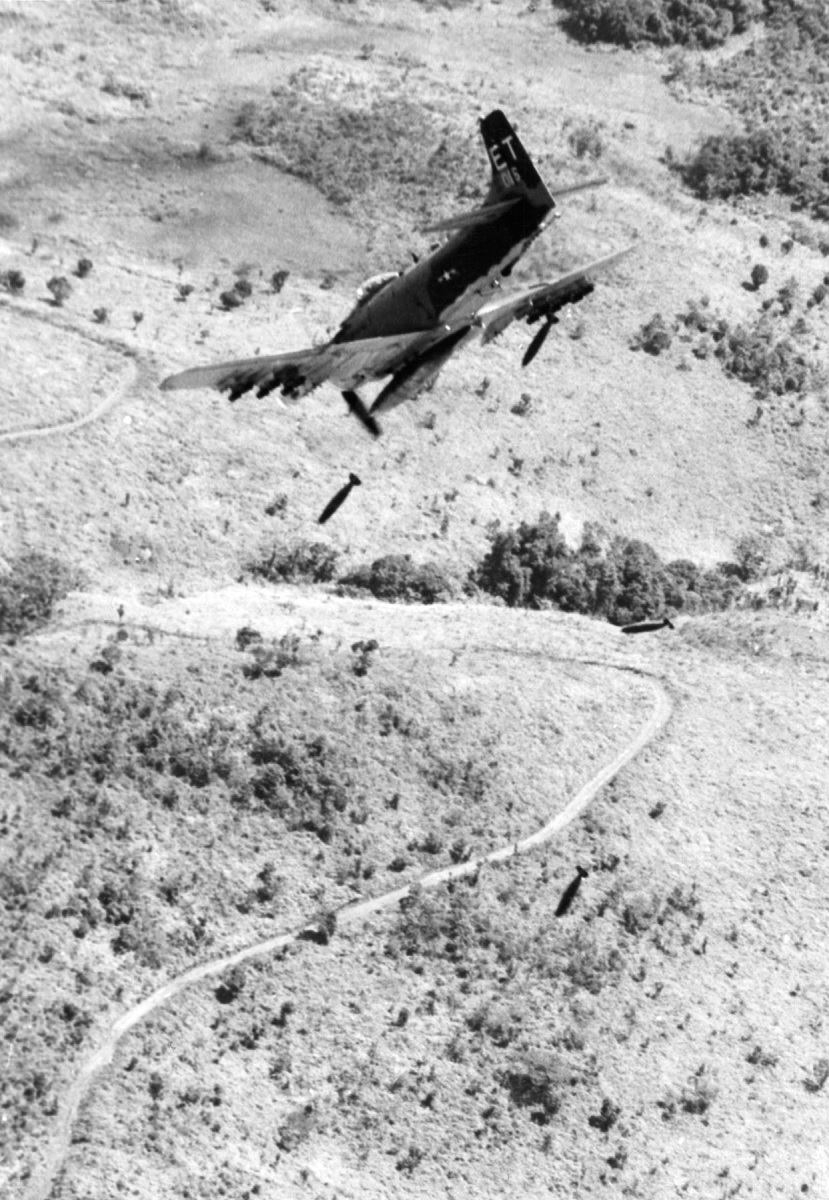“With over 150 holes in the airplane – one in the right-wing big enough to jump through – he was fortunate to be able to get the Skyraider back to Udorn. But we all survived,” Glen Mackey, A-1 pilot with 1st ACS
The Douglas AD Skyraider, which was created for the U.S. Navy during World War II, nearly disappeared before it had a chance to shine during the Vietnam War when it proved to be an excellent choice for providing close air support (CAS) to ground forces.
But, the Skyraider’s greatest contribution to the war was its support of search and rescue (SAR) missions. The fact that lone helicopters were too vulnerable to carry out combat search and rescue (CSAR) operations actually became starkly obvious early in the conflict. Due to this, a SAR task force decided in 1965 that rescue helicopters would operate in pairs and that Skyraiders would offer rescue escorts.
Initially, American Navy A-1s were used to carry out missions of this nature, but by the middle of August 1965, the 1st Air Commando Squadron (ACS) had dispatched a flight of A-1Es to Udorn Royal Thai Air Force Base (RTAFB), Thailand, to cover F-105 air strikes into high-threat areas. The U.S. Air Force’s (USAF) sophisticated CSAR program officially began with this action.
The legendary callsign “Sandy” was created in late 1965 by Capt. J.W. “Doc” George during an A-1 replacement flight to one of the numerous A-1 groups that rotated through Udorn, as detailed by Wayne Mutza in his book The A-1 Skyraider in Vietnam. Actually, it was George’s Bine Hoa departure callsign. He was asked what call sign he would like to use while in Udorn after landing there. “Sandy,” was George’s response. In addition to George’s replacement keeping the callsign, any Skyraider assigned to the SAR mission also adopted it.
Glen Mackey, an A-1 pilot with 1st ACS at the time, tells Mutza about the early stages of the Sandy operation. On September 20, 1965, Mackey and Maj. Lou Gang, who was in charge of a flight of Skyraiders from the 602nd Fighter Squadron (Commando) at the time, got the opportunity to fly in support of a SAR mission. The mission’s objective was to save the F-105’s downed pilot. “We arrived on the scene in the afternoon, in good weather, guided to the site by three remaining F-105s, who were circling at about 12,000 feet. The Air Force rescue helicopter capability at that time consisted mostly of HH-43 ‘Huskies’ positioned at NKP [Nakhon Phanom Royal Thai Air Force Base]. We were advised that two were on the way. We picked up the survival radio beeper almost immediately and circled over the area, which was hilly and completely covered with trees. The HH-43s arrived shortly thereafter.”
As Mackey recalls, Makckey and Gang circled the area once more while homing on the survival radio. “The survivors noted the helicopter and popped red smoke; the HH-43 went into a hover and started to lower the sling. I remember thinking, ‘This is really a smooth operation.’ Suddenly, the rescue helicopter was shot down, crashing almost on top of the survivor. We had seen no ground fire until then. It happened so fast that I didn’t actually see the crash. We called in Huskie number two, who started taking fire immediately on arrival in the area. He shortly called an abort, stating he had a crew member hit and was leaking fuel in the cabin.”
To give the fighters a chance to reach the downed crews, Mackey and Gang called all the local fighters and started launching airstrikes around the crash site. “We stayed in the area for about two hours until dark, trying to give the survivors the best shot at evading. One of the helicopter crew almost made it to the Thai border before being captured. When we got back to Udorn we counted about a dozen holes in the aircraft. A score of the day: one F-105 and one HH-43 down; one HH-43 and two A-1Es damaged; and no rescues. […] I thought, ‘This is going to be a very interesting month’.”
Later that month, Mackey’s flight was able to cover the successful retrieval of an F-105 pilot who had been down near Dien Bien Phu, but they also experienced two incredibly difficult and unsuccessful missions involving an F-105 and an F-4C. “Capt. Doyle Ruff took major damage from a large gun he ran across near Route 6 west if Hanoi while we were looking for the F-105 pilot in poor weather. With over 150 holes in the airplane – one in the right-wing big enough to jump through – he was fortunate to be able to get the ship back to Udorn. But we all survived.”
The video that follows, which is actually a fantastic aerial sequence from the film Flight of the Intruder, will give you an idea of what a Sandy sortie looked like.
The A-1 Skyraider in Vietnam is published by Schiffer Publishing and is available to order here.



